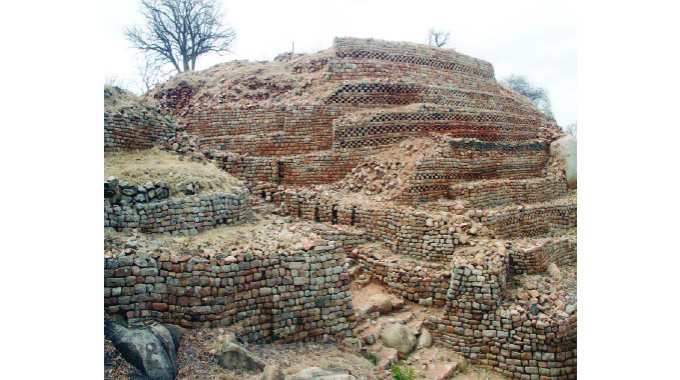Khami Monument: Timeless allure of ruins

Mashudu Netsianda, Senior Reporter
WITH twisting perambulatory passages, impressive chequered wall decorations and stones imaginatively stacked one after the other to build a magnificent fortification without the use of mortar or cement for reinforcement, the Khami Monument is a timeless allure of ruin.
The monument has a captivating history and offers breathtaking views from the rugged contours of the barren cliffs.
Sadly, despite being tucked in a picturesque rugged landscape with a raw and uncluttered beauty, the ancient city of Khami Monuments remains the least known and under-visited World Heritage Site in Zimbabwe.
It is actually the second largest complex of stone walls in the country after the Great Zimbabwe. The monument was built based on the architectural form of the Great Zimbabwe.
The site consists of several stone-built platforms where the elite once lived. The majority of the 9 000 people who lived at Khami occupied the flat area west of the museum.
It is believed to have been constructed between 1450AD and 1650AD as the capital of the BuKalanga Kingdom of Butwa of the Torwa dynasty, who ruled after the collapse of the Great Zimbabwe.
Khami Monument, which was abandoned during the Ndebele incursions of the 19th century, is composed of a complex series of platforms of dry-stone walled structures, emulating a later development of Stone Age culture.
Khami is a corruption of the Kalanga name “nkami” which means a milker.
It is now a national monument and is listed on the United Nations Educational, Scientific and Cultural Organisation (Unesco) World Heritage Sites. It was declared a national monument in 1937.
The chief’s residence was located towards the north on the Hill Ruin site with its adjacent cultivation terraces. The hill is overlooking a pool on Khami River which was solely a preserve for the chief as it was his place of bathing. No other person was allowed to get anywhere near the pool, which was later named “isiziba se ngwenya” meaning a pool for crocodiles.
The population lived in huts made of pole and burnt earth and surrounded by a series of granite walls.
These structures display a high standard of workmanship, a great number of narrow passageways and perambulatory galleries and impressive chevron and chequered wall decorations.
A Chronicle news crew yesterday went on a guided tour of Khami Monument, which is located about 22km west of Bulawayo. The place is rich when it comes to civilisation, African history and culture.
National Museums and Monuments of Zimbabwe (NMMZ) marketing officer for western region Phineas Chauke said the Khami Monument was inscribed as a World Heritage Site in 1986 on the basis of its material that is of historical and archaeological significance.
“This cultural precedence to maintain and preserve the diverse and fruitful natural environment while still preserving their past traditions is exactly why Khami Monument was chosen as exhibiting outstanding universal value,” he said.
World Heritage is the designation for places on earth that are of outstanding universal value to humanity and as such, have been inscribed on the World Heritage list to be protected for future generations to appreciate and enjoy.
Over 1 000 cultural and natural monuments are listed as Unesco World Heritage Sites. Being included on that list greatly adds to the prestige of a given location. As a result, more tourists come to visit and public funds increase.
Other sites listed as Unesco World Heritage Sites in Zimbabwe are Matobo Hills, Victoria Falls/ Mosi-oa-Tunya, Great Zimbabwe, Mana Pools National Park, Sapi and Chewore Safari Area.
“The ruins have been preserved essentially because they are rich in culture and have a vibrant story to inform about the history of our country and its peoples. The dry-stone building traditions enhance the sacredness of the area, where human presence is traceable over 100 000 years,” said Mr Chauke.
He said although Khami Monument remains a largely undisturbed archaeological site, it is still being used by a number of people in surrounding communities for spiritual purposes.
“One of the platforms at Khami Monument, Cross Platform is believed to have served as religious purposes where people would come and reconnect with their ancestorial spirits. It is no surprise that even today, the ruins still carry a lot of spiritual meaning for the local communities in and around Bulawayo,” he said.
Mr Chauke said the architecture of the site and the archaeological artefacts provide evidence for an exceptional understanding of strong, united, early civilisations.
“They also offer information on the property’s complex socio-economic, religious and spiritual significance for the local communities and for the overall chronological development of Zimbabwe tradition; initiated in Mapungubwe in South Africa, extending to Great Zimbabwe, and through the emergence of later states,” he said.
Mr Chauke said the archaeological remains are also a testament to long-distance historic trade links with the Portuguese and the wider world.
“The diverse range of imported artefacts provide evidence of 15th and 17th century Spanish porcelain, Rhineland stoneware and Ming porcelain, many of which are on display in the Museum of Natural History in Bulawayo. There is also a monumental granite cross which illustrates the contact with missionaries at a traditionally revered and sacred spiritual site,” he said.
Khami Monument is dominated by a series of terraced stone ruins, often highly decorated. The largest comprises of three, tiered platforms that was the home of the chief and his family.
The imposing front façade marked the main entrance. Nearby are the Cross Ruin with its mysterious stone Dominican Cross and the Northern Platform once used to process gold.
The Precipice Ruin was a ritual centre that has the longest decorated stonewall of its kind. The nearby Passage Ruin consists of two adjoining semi-circular platforms accessed by a narrow passageway.
Like many of the other smaller platforms, it is likely that it was once occupied by one of the elite officials of the state.
Visitors are able to wander around the site on several paths taking in the site’s unique cultural and natural heritage.
Renowned historian and scholar, Mr Pathisa Nyathi said Khami began sometime after the fall of the Great Zimbabwe State.
“Construction at Khami began sometime after 1410AD and it was abandoned at about 1640AD. The first organised stage is seen at Mapungubwe State in Shashe and Limpopo at around 11th century and thereafter there is a shift to the Great Zimbabwe around 1200AD to 1400AD,” he said.

“We do not know what happened at the Great Zimbabwe but we understand there was a misunderstanding and two groups emerged. The other one went west and that is the one that set up the Torwa Dynasty.”
Mr Nyathi said the second group that went northwards is believed to have built the Mutapa State.
He said one of the major evidences to support the timeline was the architecture of the stone walls.
“Decorations improved with time. Mapungubwe has rough stone cuts and the designs are not as pretty as those at Khami and Dhlodhlo,” said Mr Nyathi.
Ms Perpetua Mzama, a tour guide at Khami Monuments said there are quite a number of recreational activities for visitors to the site.
Some of the activities include bird viewing, picnicking, educational tours and camping.
Some of the bird species found at Khami Monuments include the African fish eagle, lilac-breasted roller, African grey horn hill, spotted eagle owl, cardinal woodpecker and pied king fisher among others.
There are also small animals such as dwarf mongooses, velvet monkeys, scrub hares and klipspringers.
Entrance fee for local adults is US$4 and US$1 for children. Tourists from the Sadc region pay US$7 to access the monument while those from other countries outside the region pay US$10. — @mashnets











Comments